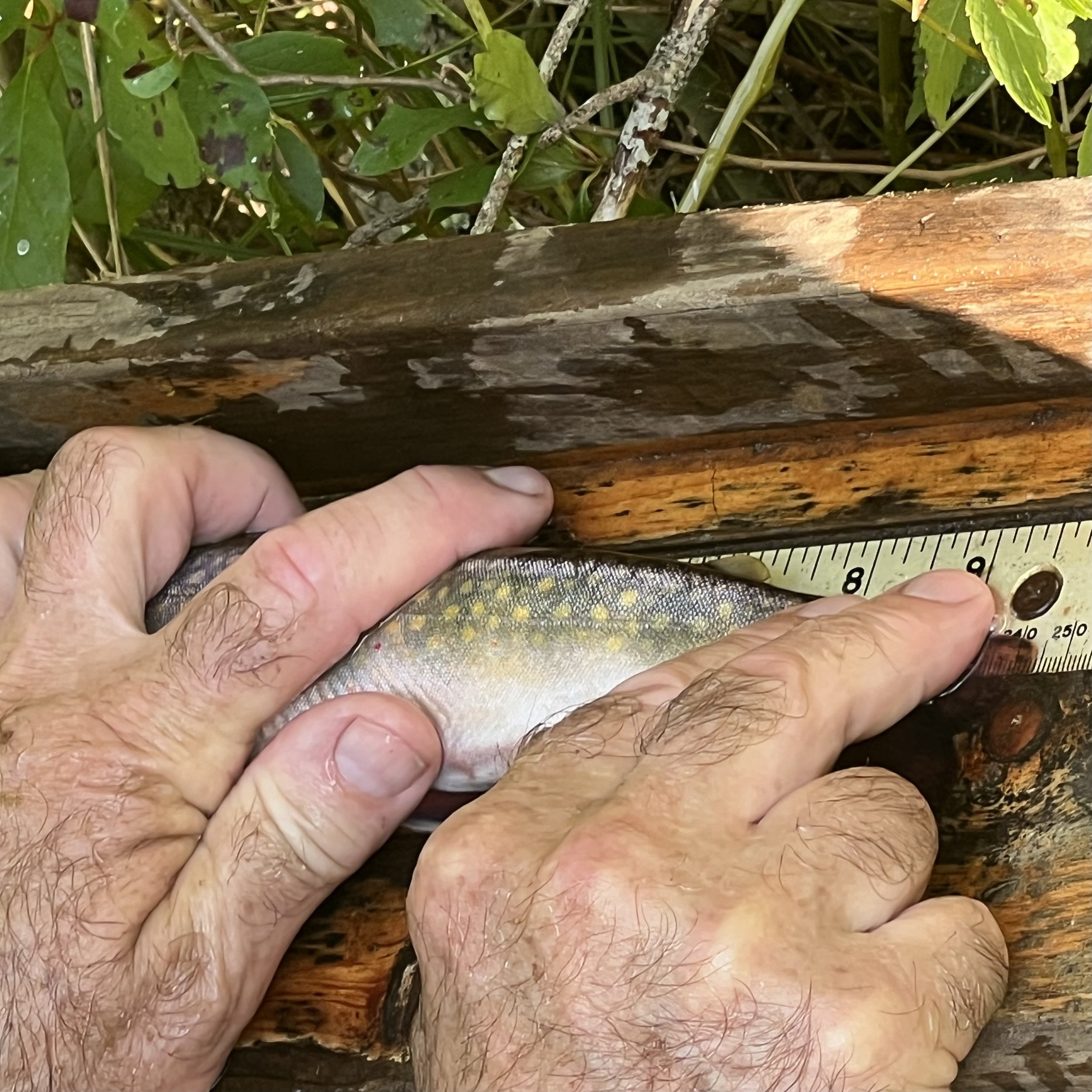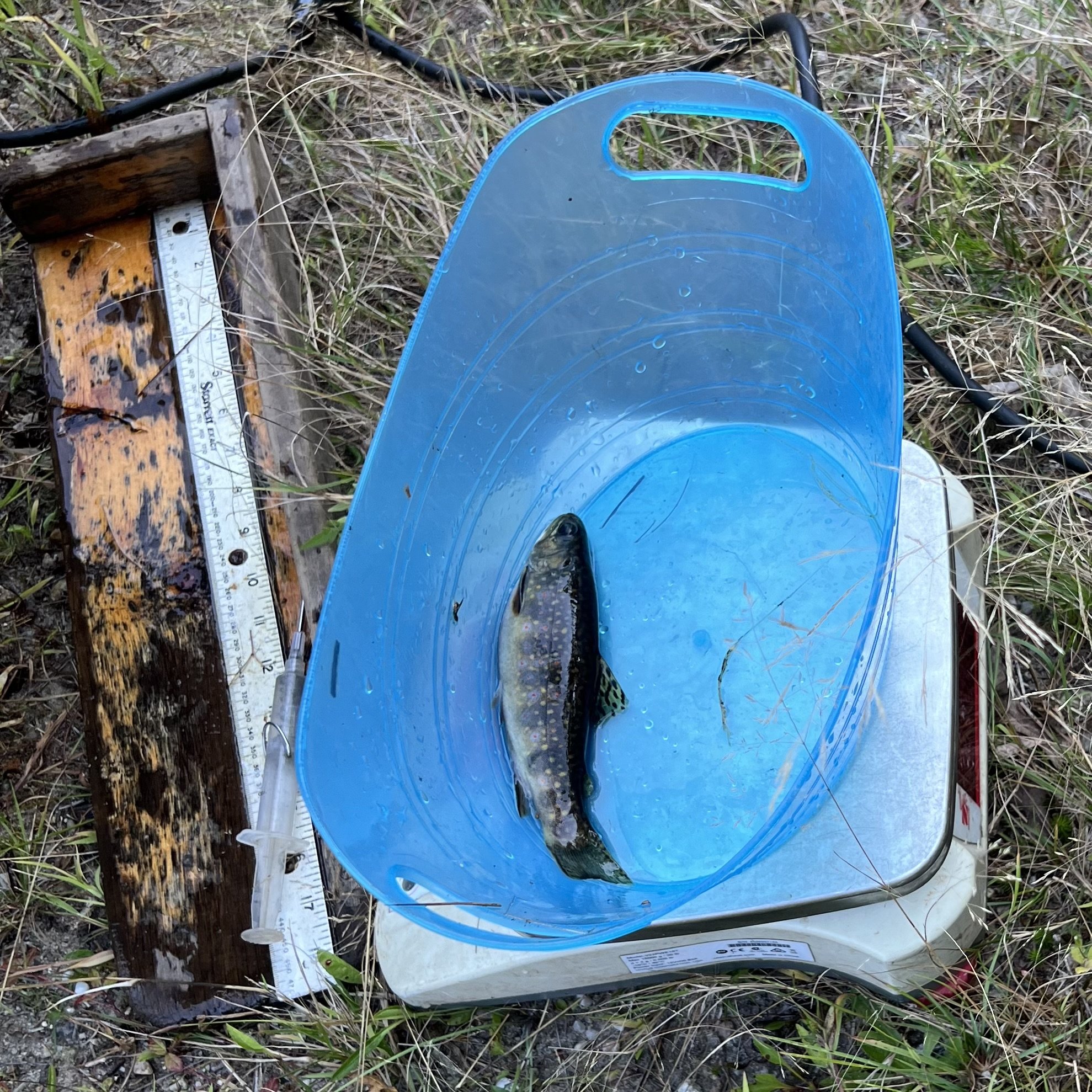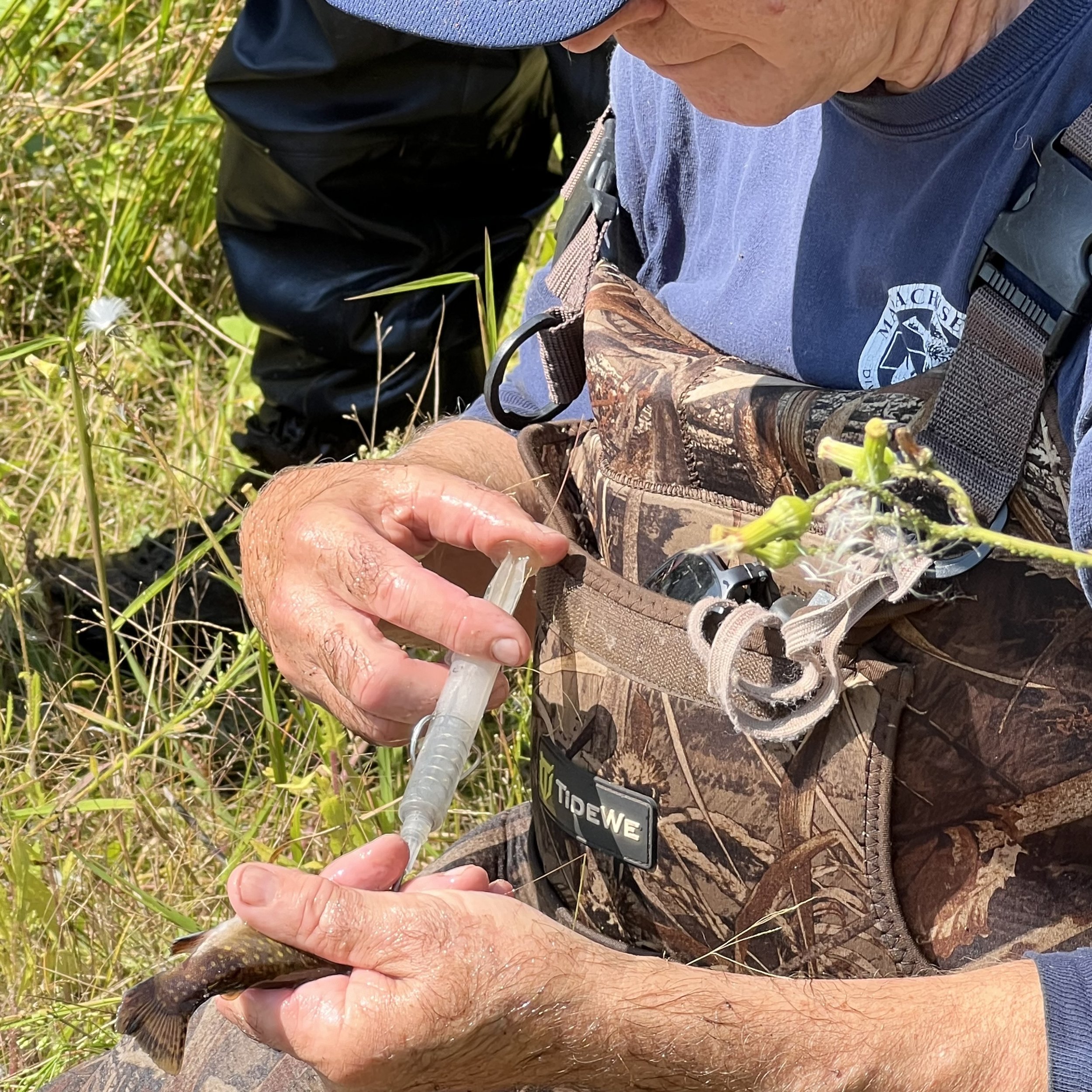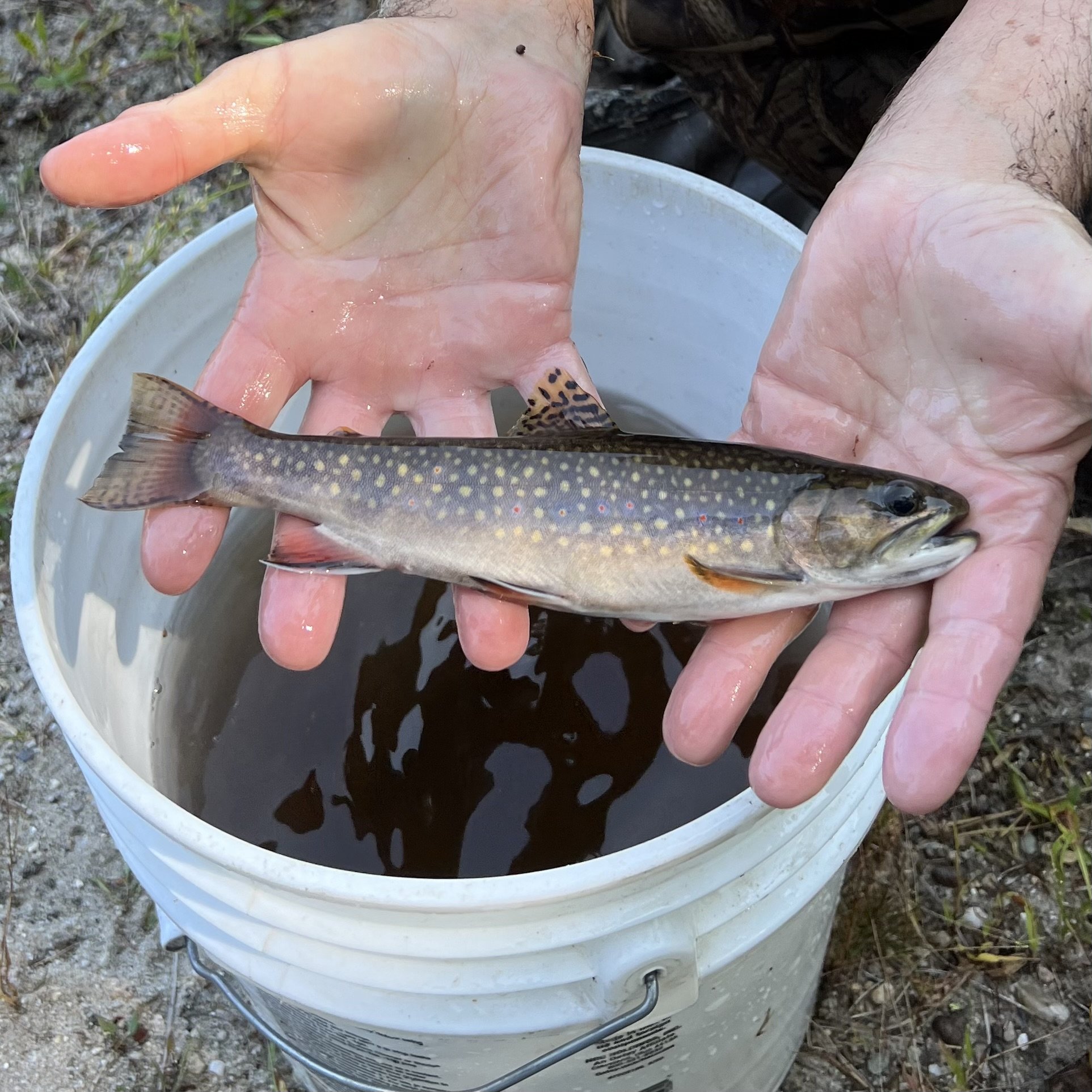Shock and Awe: Electrofishing the Childs River
Steve Hurley and team of survey technicians electrofishing the upper Childs River.
On a warm September morning I joined fisheries biologist Steve Hurley and his team on a lower section of the Childs River near where it enters Waquoit Bay. Steve, with the Massachusetts Division of Fisheries and Wildlife, graciously allowed me to participate in one of the state’s biannual electrofishing surveys of the Childs River. Having conducted fisheries research from Maine to Alaska, but never with electrofishing gear, I was excited.
Electrofishing is a non-lethal technique used to study fish populations. By passing an electrical current through the water, fish can be temporarily stunned for capture, examination, tagging, and release. The data collected are invaluable for understanding fish size, abundance, and habitat usage.
As we suited up in waders and prepared the equipment, Steve provided safety instructions. The 400-volt current from his backpack required caution, though our waders provided insulation. Stepping into the river Steve activated the electrofishing unit. The backpack beeped, and a current passed from the tip of the anode ring back to the rattail cathode that hung behind the backpack. As Steve headed upstream the team followed in behind, nets and buckets at the ready, prepared to scoop up any stunned fish. Within seconds the riverbed revealed its hidden inhabitants - American eels. These slippery creatures, I soon learned, were the most abundant species in the Childs River. But it wasn’t eels we were after today, it was native brook trout, Salvelinus fontinalis.
Fisheries biologist, Steve Hurley, of the Massachusetts Division of Fish and Wildlife preparing to electrofish the Childs River in East Falmouth, MA.
Why Brook Trout?
Beyond being prized as a sport fish, brook trout are sentinels of the ecosystem, their presence or absence a barometer of a river's health. Brook trout are a cold water species preferring water temperatures from 45 to 65 degrees Fahrenheit. On Cape Cod, they thrive in the cold, clear, coastal groundwater-fed streams. Unlike the more commonly known land-locked form, Cape Cod’s native trout are anadromous - meaning they use both fresh and saltwater environments during their life cycle. These are sea-run brook trout, or ‘salters’.
The Childs River once teemed with brook trout - a prized catch for anglers like Daniel Webster and President Grover Cleveland in the 1800s. In the late 19th century the river was modified to install a mill dam near present-day Carriage Shop Road. Throughout the 20th century, cranberry farming would continue to transform the river valley. Stream channels were filled, valleys were widened to increase the farming area, shade trees were removed, and ditches and dikes were added to the bog areas. The combination of dams, deforestation, and stream modifications limited access to aquatic habitat, raised water temperatures, and diminished the abundance of trout and other fish species. By the turn of the 21st century the Childs River trout population was nearly gone. In 2006, only a single adult brook trout was found in the Childs River.
A brook trout caught in the lower river, bearing the telltale scars of a birdstrike along its back.
In response to the lack of trout in the Childs, and a growing population in the nearby Quashnet River, nearly a hundred adult fish were relocated to the lower Childs River between 2008 and 2010. This effort, in conjunction with habitat improvements done by the Falmouth Rod and Gun Club, successfully reestablished brook trout to the southern section. However, access to their historical range in the upper river, north of the mill dam, remained blocked due to limited fish passage and warm water conditions.
Around this same time, the cranberry industry in eastern Massachusetts experienced economic headwinds, and the remaining bogs on the upper Childs River were abandoned. Seeing an opportunity, the Falmouth Rod and Gun Club began the long and arduous process of acquiring the former mill pond and bog lands, with the aim of restoring the ecological function of upper Childs River. To accomplish this, the club developed a large network of collaborators that involved funders, contractors, and permitting agencies, including the Association to Preserve Cape Cod, which helped fund and manage the project.
The survey team makes its way through the heavy underbrush lining the lower Childs River valley.
The project required the removal of culverts, irrigation ditches, water control structures, and several feet of sand that had been placed on the bogs over the preceding decades. The mill dam was removed and a modified stream channel was dug along the western edge of the bog areas. Bog surfaces were tilled to expose long dormant native grass, shrub, and tree seeds. Tree stumps and trunks were placed along the river edge to provide shade and habitat for fish, and aerial habitat for birds. Native plantings in the restored area populated the newly exposed peat soil. This large-scale restoration project sought to restore fish passage and habitat throughout the system, as well as to improve overall water quality.
Water temperature in the middle section of the Childs River pre- and post-restoration. The dam removal occurred in January 2021. Note the cooler summer water temperatures and warmer winter temperatures post-restoration. Post-restoration, the Childs River is one of the coldest rivers on Cape Cod. Data source: Cape Cod Rivers Observatory, https://www.caperivers.org
Sampling the Fish
The restoration work is why we are all here. We are monitoring the brook trout population in the Childs River and trying to understand how trout are utilizing the newly restored areas. Basically, we want to find out if all of the work was worth it, and what steps must be taken to ensure the population persists? But how does one monitor brook trout?
Steve carefully makes his way up the river - us field technicians following closely behind. He’s waving the anode ring from one side of the river to the other, trying to make sure that no overhang, log, rock, or pool go untouched. Electrofishing is not 100% efficient. Only about 40% of the fish that are encountered are caught, with smaller fish tending to be less affected by the electrical current, and more difficult to capture.
This isn’t a census - our objective isn’t to capture and record every brook trout in the river. This is a survey where we take a sample and try to make inferences about the overall health of the population. The larger our sample, the more precise our information will be. We plan to sample five sections of the river, from the lower tidal section all the way to the upper river in the area of the former Farley cranberry bog. Our sampling effort is measured in catch per seconds - how many fish we catch per second that the electrofishing unit is turned on. This catch rate can be compared across years, or across sections, providing a relative index of abundance.
A bucket of brook trout waiting to be sampled and tagged.
“Trout!” Steve shouts. There’s a mad dash to net the writhing fish before the stun wears off and the fish skirts away. Success! Our first brook trout of the morning. A nice sized fish that Steve passes back to the technician behind him, who in turn places it in a waiting bucket. We caught a few more trout in the lower tidal sections, but not many. The river in this area was shallow, heavily sedimented, and lacking cover from avian predators like blue heron and osprey. After a few hundred yards of river length, we stopped to work up the catch. We’ll be recording a lot of information on the fish - location of capture, length, weight, and any unusual markings or coloration. The first fish we sample has several inverted ‘V’ shaped marks along its back - the telltale signs of a narrow miss with a blue heron.
Steve Hurley holding a fish while he explains the differences in shape and coloration between male and female brook trout.
The length of a fish tells us its approximate age. Brook trout in these rivers are not long-lived. The maximum age is about 4 years old, though most of the fish we’ll see will be age-2 and younger. In the cooler environments like northern New England, trout live longer. In the warmer southern extent of their range, they grow fast and die young. One of the first fish we measure is about 240 mm - likely a 2-year old.
A native Childs River brook trout on the length measuring board. This trout measured in at 244 mm.
After recording the fish length, Steve moves the fish from the wooden measuring board to the field scale where he obtains a weight measurement. The ratio of weight-to-length is called a condition factor, and Childs River fish have a high condition factor. These are some fat fish! As we’ve been seeing first hand, there’s no shortage of forage fish to feed on - like eels, mummichugs, and sticklebacks.
A brook trout on the scale in the process of being weighed. The ratio of a weight-to-length in a fish can tells us a lot about its condition and health. This is appears to be a particularly healthy fish.
Before releasing the fish back to the river, Steve injects a passive integrated transponder, or PIT tag, into its abdomen. The tags stay in the fish for life, though occasionally they do fall out - or as Steve has observed - hitch a ride in the belly of an otter! PIT tags are essentially a fish EZ-pass. Each tag contain an internal chip that is activated when it nears an antenna array, or reader. Once activated, it transmits its identity to the reader which then records the time of the tag ‘ping’. By deploying multiple antenna arrays throughout a river system, biologists can gain an understanding of fish movement and habitat usage. It’s from PIT tagging that biologists hope to uncover some of the mysteries of the sea-run brook trout - like how often they migrate to salt water.
Steve Hurley injecting a passive integrated responder (PIT) tag into the abdomen of a brook trout.
What We Found
We sampled two sections of the lower river before wading back down to our vehicles to drive the 5 minutes north to the middle section of the river. The catch from the lower river was decent - being my first time out I didn’t have a sense of whether we had caught a lot or a little, though it seemed like there was a good number of young fish. These are called young-of-the-year. These are fish that were spawned in early-winter and hatched in late-winter. After a spring and summer of growth, they’re now about 110 mm.
Young-of-the-year are an indication that the population is successfully spawning and self sustaining. The number of young-of-the-year we encounter is a gauge of the future health of the population. Failure to detect young fish means that the population is likely to decrease in subsequent years. For a fish as short-lived as brook trout, with only about 4 age classes in the population, back-to-back years of poor spawning success could spell doom for a small stream population. There are a lot of factors affecting spawning success including the number of adult trout, available spawning habitat, fish condition, environmental conditions, prey availability, predation, and the list goes on.
The length frequency distributions of September-captured brook trout from the Childs River between 2008 and 2022. Source: Association to Preserve Cape Cod, apcc.org
The middle section of the river is the start of the most recent restoration work. It was here that the old mill dam was removed. What was once a warm stagnant pond, is now a meadow with a coldwater stream flowing through it. The goldenrod has taken hold amongst the planted cedar and maple trees. These plantings will one day provide critical shade from the warm summer sun, and cover from the waiting birds.
A noticeable difference in the middle section of the river is the depth and type of the bottom sediment. While there are pockets of gravel, the majority of the bottom is covered in a thick layer of mucky, organic, sediment. As we walk the river we kick up a thick plume of mud that trails off behind us. These coastal streams lack the vertical gradient needed to establish a good flushing current. As result, a lot of the residual sediment from the old bogs that has washed into the stream, remains. The aquatic vegetation that grows prolifically in the unshaded stream traps even more sediment. The combination of the two has the potential to clog the stream, reduce water flow, and limit fish passage.
A good sized brook trout caught in the upper Childs River in the former Farley Bogs. This trout is about 2 to 3 years old.
To some extent, the sediment challenges were expected and accounted for in the restoration design. Multiple sediment traps had been installed along the river. These are essentially deep pools where sediment settles out. The traps are maintained through the regular removal of built-up deposits. Despite these sediment traps, sedimentation in the river remains problematic. The sediment covers the gravel substrate needed for effective spawning, and the increasing sediment depth shallows the river, making it both warmer and easier for prey to capture a passing trout.
As we continued our electrofishing survey we encountered more trout, a few more eels, and a handful of other native species like pumpkinseed sunfish. The restored sections of the river showed promise, but the sedimentation and vegetation challenges were evident. Despite these challenges, the restoration efforts were undeniably a success. The Childs River, once nearly devoid of brook trout, now supports a thriving population of healthy fish. The river's ecosystem has been rejuvenated, providing habitat for a diverse array of aquatic life.
The future of the Childs River is uncertain, but the work to protect and restore it is ongoing. Continued monitoring, maintenance, and habitat improvements will be crucial in ensuring the long-term survival of the brook trout, and the health of the river.
As we waded out of the river, tired but satisfied, I couldn't help but feel a sense of hope. The Childs River is a testament to the power of conservation. With continued dedication and effort, it will serve as a model for river restoration, and a symbol of nature's resilience.
Steve Hurley using a laptop computer to download fish tag data from the field reader. The antenna array can be seen in the background (upper right).
The author currently serves as a restoration ecologist for the Association to Preserve Cape Cod (APCC). A special thank you to APCC and the Massachusetts Division of Fisheries and Wildlife for this opportunity.













